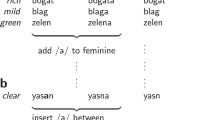Abstract
No matter how comprehensive the coverage of a natural language interface, users will invariably provide unparsable input: idiosyncratic phrases, linguistically deviant utterances, or sentences simply beyond the linguistic sophistication of the interface. Although individual users differ significantly from each other in their preferred linguistic expression, they show surprising consistency in multiple interactions over time. Addressing both observations, a general framework is developed for automated adaptation to the preferred and idiosyncratic linguistic behavior of individual users. In essence, a method for flexible recovery and completion of partial parses is developed, with subsequent individualized extensions to a base grammar. Thus, the system adapts to the user by growing its grammar dynamically to acquire her preferred forms of expression and recognize them directly in future interactions.
Access this chapter
Tax calculation will be finalised at checkout
Purchases are for personal use only
Preview
Unable to display preview. Download preview PDF.
Similar content being viewed by others
References
Boggs, W. M., J. G. Carbonell, M. Kee and I. Monarch (1985): The DYPAR-I Tutorial and Reference Manual. Technical Report, Computer Science Dept., Carnegie-Mellon Univ., Pittsburgh, PA. [LEHM*: 167]
Carbonell, J. G. and P. J. Hayes (1981): Dynamic Strategy Selection in Flexible Parsing. In: Proc. of the 19th Annual Meeting of the Association for Computational Linguistics, Stanford, CA, 143–147. [LEHM*: 167]
Carbonell, J. G. (1983): Discourse Pragmatics in Task — Oriented Natural Language Interfaces. In: Proc. of the 21st Annual Meeting of the Association for Computational Linguistics, Cambridge, MA, 164–168. [LEHM*: 164]
Carbonell, J. G. and P. J. Hayes (1983): Recovery Strategies for Parsing Extragrammatical Language American Journal of Computational Linguistics 9, 123–146. [LEHM*: 163f.]
Cobourn, T. F. (1986): An Evaluation of Cleopatra, a Natural Language Interface for CAD. Master’s Thesis, Dept. of Computer Science, Carnegie Mellon Univ., Pittsburgh, PA. [LEHM*: 188]
Durham, I., D. D. Lamb and J. B. Saxe (1983): Spelling Correction in User Interfaces. Communications of the ACM 26, 764–773. [LEHM*: 170]
Fain, J., J. G. Carbonell, P. J. Hayes and S. N. Minton (1985): MULTIPAR: A Robust Entity-Oriented Parser. In: Proc. of the 7th Cognitive Science Society Conference, Irvine, CA, 110–119. [LEHM*: 164f.]
Good, M. D., J. A. Whiteside, D. R. Wixon and J. J. Jones (1984): Building a User-Derived Interface. Communications of the ACM 27, 1032–1043. [LEHM*: 183, 188]
Hayes, P. J. (1984): Entity-Oriented Parsing. In: Proc. of the 10th International Conference on Computational Linguistics and 22nd Annual Meeting of the Association for Computational Linguistics, Stanford Univ., Stanford, CA, 212–217. [LEHM*: 165]
Minton, S. N., P. J. Hayes and J. E. Fain (1985): Controlling Search in Flexible Parsing In: Proc. IJCAI-85, 785–787. [LEHM*: 165]
Mitchell, T. M., R. M. Keller and S. T. Kedar-Cabelli (1986): Explanation-Based Learning: A Unifying View. Machine Learning 1, 47–80. [LEHM*: 193]
Rich, E. (1984): Natural Language Interfaces. Computer 17, 39–47. [LEHM*: 173]
Schuster, E. (1985): Grammars as User Models. In: Proc. IJCAI-85, 20–22. [LEHM*: 164]
Slator, B. M., M. P. Anderson and W. Conley (1986): Pygmalion at the Interface. Communications of the ACM 29, 499–514. [LEHM*: 184]
Editor information
Editors and Affiliations
Rights and permissions
Copyright information
© 1989 Springer-Verlag Berlin Heidelberg
About this paper
Cite this paper
Lehman, J.F., Carbonell, J.G. (1989). Learning the User’s Language: A Step Towards Automated Creation of User Models. In: Kobsa, A., Wahlster, W. (eds) User Models in Dialog Systems. Symbolic Computation. Springer, Berlin, Heidelberg. https://doi.org/10.1007/978-3-642-83230-7_7
Download citation
DOI: https://doi.org/10.1007/978-3-642-83230-7_7
Publisher Name: Springer, Berlin, Heidelberg
Print ISBN: 978-3-642-83232-1
Online ISBN: 978-3-642-83230-7
eBook Packages: Springer Book Archive




